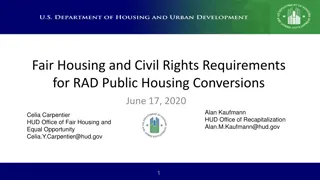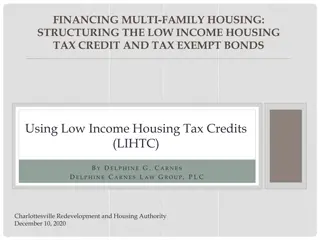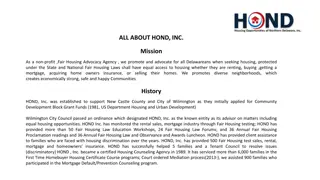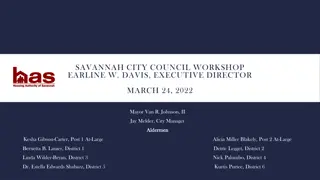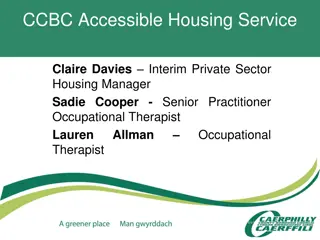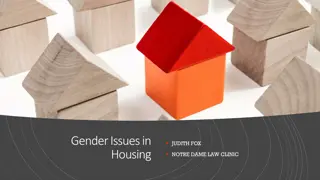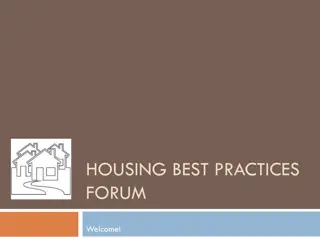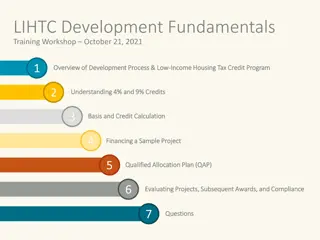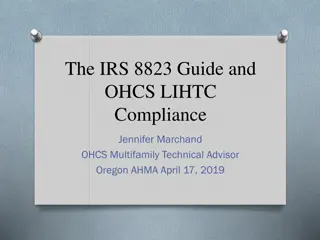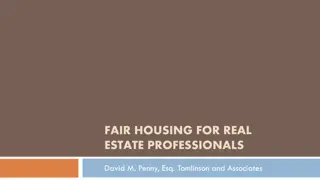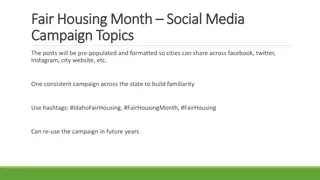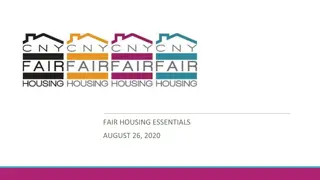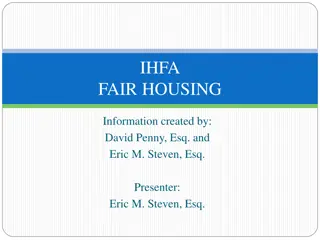Fair Housing Laws and LIHTC Basics
Explore the basics of Fair Housing laws and Low Income Housing Tax Credit (LIHTC) properties, including applicable regulations, reasonable accommodations, and key issues. Learn about protected classes, exemptions, and guidelines for ensuring compliance in housing provision.
Download Presentation

Please find below an Image/Link to download the presentation.
The content on the website is provided AS IS for your information and personal use only. It may not be sold, licensed, or shared on other websites without obtaining consent from the author.If you encounter any issues during the download, it is possible that the publisher has removed the file from their server.
You are allowed to download the files provided on this website for personal or commercial use, subject to the condition that they are used lawfully. All files are the property of their respective owners.
The content on the website is provided AS IS for your information and personal use only. It may not be sold, licensed, or shared on other websites without obtaining consent from the author.
E N D
Presentation Transcript
Fair Housing in Focus LIHTC Basics & Reasonable Accommodations
Overview: LIHTC Basics Applicable Fair Housing Laws Reasonable Accommodation/Modification Policy Guidelines
LIHTC BASICS Knowing Which Regulations Apply is Key
Q: Which Fair Housing Laws are applicable to Low Income Housing Tax Credit Properties? A: A. Fair Housing Act as amended in 1988 (CFR Part 8) B. Americans with Disabilities Act C. Section 504 of the Rehabilitation Act of 1973 (CFR Part 100 et seq) D. All of the above E. None of the above
Q: Which Fair Housing Laws are applicable to Low Income Housing Tax Credit Properties? A: A. Fair Housing Act as amended in 1988 (CFR Part 8) B. Americans with Disabilities Act C. Section 504 of the Rehabilitation Act of 1973 (CFR Part 100 et seq) D. All of the above E. None of the above
Q: Which Fair Housing Laws are applicable to Low Income Housing Tax Credit Properties with additional federal assistance? A: A. Fair Housing Act as amended in 1988 (24 CFR Part 8) B. Americans with Disabilities Act C. Section 504 of the Rehabilitation Act of 1973 (24 CFR Part 100 et seq) D. All of the above E. None of the above
Q: Which Fair Housing Laws are applicable to Low Income Housing Tax Credit Properties with additional federal assistance? A: A. Fair Housing Act as amended in 1988 (24 CFR Part 8) B. Americans with Disabilities Act C. Section 504 of the Rehabilitation Act of 1973 (24 CFR Part 100 et seq) D. All of the above E. None of the above
Fair Housing Act AtaGlance Applicable whether or not the housing is provided through a federal program Seven protected classes Exemption from Familial Status requirement for housing for older persons 55 years of age and older Reasonable Accommodation/Modification are key issues
Seven Protected Classes + 1 Race Color Religion Sex National Origin Disability Family Status Nevada: Transgender
ADA AtaGlance Extends the protections first regulated under the Fair Housing Act to the marketplace Title III Public Accommodations Applies to common areas of property open to general public Title II Activities of Public Entities Requires public entities to make both new and existing housing facilities accessible to persons with disabilities.
Section 504 AtaGlance Prohibits discrimination on the basis of disability in programs and activities receiving federal funds. Programs and services be conducted in the most integrated setting appropriate. Requires designation of a Section 504 Coordinator. Requires Section 504 Self Evaluations and Transition Plans
Other Civil Rights Laws Many states have enacted additional protected classes (i.e., Sexual Orientation, Marital Status, etc.) When there is a conflict between federal and state civil rights laws, the regulation that is the most stringently protective of the protective class will apply.
REASONABLE ACCOMMODATION/MODIFICATION Establishing Policy is Key
A Cautionary Tale Resident sought unit transfer as reasonable accommodation for disability Request was denied resulting in injury to resident
Terms of Settlement: Pay resident $22,500 Revise policies and designate a Section 504 Coordinator Redesign an accessible unit on an accessible route with accessible parking to meet UFAS requirements Alter seven designated accessible parking spaces Owner, managing agent and staff to attend FHA and Section 504 training.
Reasonable Accommodations It is unlawful for any person to refuse to make a reasonable accommodation in rules, policies, practices, or services, when such accommodations may be necessary to use and enjoy a dwelling unit, including public and common use areas (24 CFR 100.204(a))
Reasonable Modifications It is unlawful for any person to refuse to permit, at the expense of a handicapped person, reasonable modifications of an existing premises if the proposed modifications are necessary to afford the handicapped person full enjoyment of the premises of a dwelling (24 CFR 100.203(a))
Why Have a Policy? Helps individuals with disabilities in making requests Help you assess requests in a uniform manner Provides record to show that requests receive proper consideration
Reasonable Accommodation/Modification Policies HUD strongly recommends Dangers associated with accommodating all requests Absence of policy can equate to having no basis for denying requests Should contain 3 main components: Mission Statement Definitions Process



